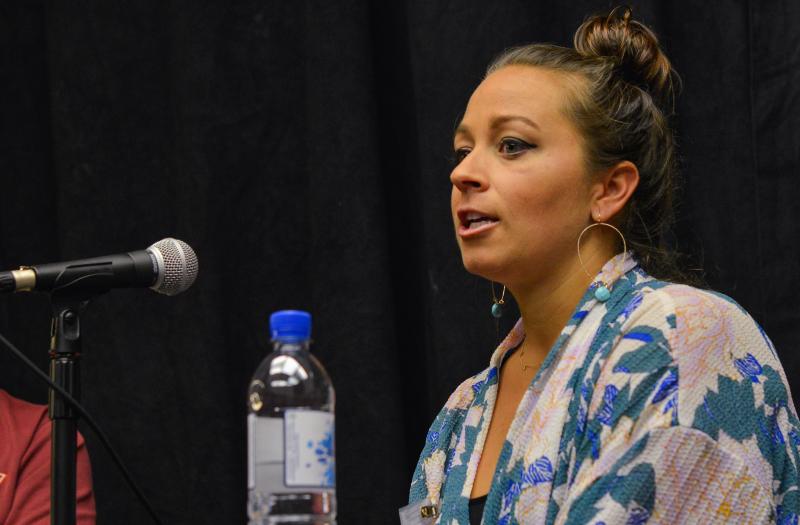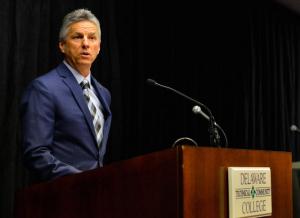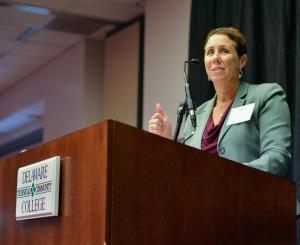Successful business is all about collaboration
A year into a schedule of 20-hour days, seven-days-a-week at their new Fenwick Island eatery, One Coastal Restaurant, Carlie Carey said she and her now-husband Scott knew something had to change.
There was a vision and a dream, but it was breakfast, lunch and dinner, she said of exhaustion-filled days.
Three years later, Carey said her One Coastal Restaurant still faces challenges. It was the realization the couple couldn’t do everything on their own that saved them, she said.
“It was a liberating moment when we accepted that we couldn’t do it all by ourselves,” Carey said to the hundreds of folks attending the 24th annual Today and Tomorrow Conference. “Without collaboration, we would have gone down in flames.”
Collaboration was the theme of the conference, held Oct. 25 at Delaware Technical Community College Owens Campus in Georgetown. The annual gathering brings together the county’s business people, elected officials and other folks for a morning of learning and networking.
For the Careys, collaboration meant working with local farmers like Salisbury’s Baywater Farms, which provides the restaurant with fresh greens.
For keynote speaker Gov. John C. Carney, collaborating with the stakeholders began the day after he took office with signed Executive Order 1, which created a working group to study how Delaware’s public and private sectors can work together to improve economic development in Delaware. He has also held nearly two dozen town hall-style meetings and small business round table discussions.
It’s about addressing the challenges the state faces, Carney said.
“The economy today in Delaware is a lot different than it’s ever been,” he said.
The speaker who may have made the best case for collaboration was Dr. Mark Brainard, Delaware Technical Community College president. Citing stories done by national publications, Brainard said the need for a strong community college system has never been greater. He said he’s working with local businesses and school districts to create programs that produce a strong, targeted workforce.
As employers, business owners are the best source of real-time data the college can use to develop relevant programs, Brainard said.
Brainard also said future students must be reminded that future manufacturing jobs are different from the dark, dirty and dangerous manufacturing jobs of the past.
Sussex County by the numbers
As usual, Ed Simon, who retired in 2007 from Delaware Department of Labor after 32 years, presented a statistical snapshot of Sussex County.
Simon said, since 2011, Sussex had a net gain of 10,000 jobs, representing about 14.6 percent growth.
Existing home sales for 2017 are well ahead of the same period for 2016, said Simon.
More than 2,500 homes were sold in Sussex County during the first half of 2017, Simon said. In total, he said, more than $841 million of real estate had changed hands during the first six months of 2017.
Simon said the unemployment rate for Sussex sits at 4.7 percent in 2017, which is up 0.3 percent from 2016, and 0.1 percent higher than the state average of 4.6 percent. It’s not unusual for Sussex unemployment to be slightly higher than the state’s – according to Simon’s statistics, Sussex County has had a slightly higher unemployment rate in six of the last eight years.
Simon said the number of new housing units being built is below the 2004 and 2005 levels, but they’re still far out pacing Kent and New Castle counties – both of which sit below 1,500 new homes, while Sussex is above 2,500.
Simon said population growth is steady in Sussex, but it’s because people are migrating to the area at a faster rate than residents are dying. He said the current population of the county sits near 216,000 people, and is expected to be close to 255,000 by 2035.
Simon said Sussex lags behind Kent and New Castle in median household income and average annual wage. Simon said the median household income is $53,751 in Sussex, $54,976 in Kent and $65,476 in New Castle. He said the average annual wage is $38,559 in Sussex, $41,668 in Kent and $60,007 in New Castle.





























































